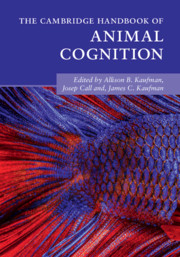Book contents
- The Cambridge Handbook of Animal Cognition
- The Cambridge Handbook of Animal Cognition
- Copyright page
- Dedication
- Contents
- Figures, Tables, and Boxes
- Contributors
- Acknowledgments
- Introduction
- Part I Communication and Language
- 1 Animal Communication Overview
- 2 Communication in Ant Societies
- 3 Symbolic Communication in the Grey Parrot
- 4 Communication in Dogs and Wolves
- 5 Semantic Communication in Primates
- Part II Memory and Recall
- Part III Social Cognition
- Part IV Social Learning and Teaching
- Part V Numerical and Quantitative Abilities
- Part VI Innovation and Problem-Solving
- Index
- References
1 - Animal Communication Overview
from Part I - Communication and Language
Published online by Cambridge University Press: 01 July 2021
- The Cambridge Handbook of Animal Cognition
- The Cambridge Handbook of Animal Cognition
- Copyright page
- Dedication
- Contents
- Figures, Tables, and Boxes
- Contributors
- Acknowledgments
- Introduction
- Part I Communication and Language
- 1 Animal Communication Overview
- 2 Communication in Ant Societies
- 3 Symbolic Communication in the Grey Parrot
- 4 Communication in Dogs and Wolves
- 5 Semantic Communication in Primates
- Part II Memory and Recall
- Part III Social Cognition
- Part IV Social Learning and Teaching
- Part V Numerical and Quantitative Abilities
- Part VI Innovation and Problem-Solving
- Index
- References
Summary
This chapter provides a broad overview of terminology and concepts in the study of animal communication. First, we focus on the evolutionary origins or phylogenetic causes of communicative signals. We address how communication systems can arise under several circumstances by increasing the reproductive success of both senders and receivers of signals. We summarize terminology describing what is communicated (self-reporting and other-reporting), how it is communicated (different modalities) and to whom it is communicated (conspecifics, heterospecifics). We further discuss how signal design is influenced by the risk of deception. The debate between the information and manipulation perspective of animal communication is briefly outlined. The second part of the chapter focuses on proximate aspects of animal communication. We describe signal acquisition in animals through ultimate mechanisms (biological inheritance, phylogenetic ritualization) and proximate mechanisms (ontogenetic ritualization, cultural learning) with a particular focus on learning. We further discuss signal selection, i.e., to what degree some animals have flexible control over signals and how they adjust them according to the recipient. Last, we discuss new directions and open questions in the study of animal communication, i.e., considerations of compositionality and multimodality, turn-taking, repertoire acquisition and development, flexibility and memory, and the problem of using a one-size-fits-all approach for understanding animal communication systems.
- Type
- Chapter
- Information
- The Cambridge Handbook of Animal Cognition , pp. 5 - 35Publisher: Cambridge University PressPrint publication year: 2021
References
- 1
- Cited by



